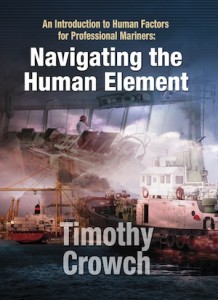About the Book

“Navigating the Human Element” provides an easy-to-read and simple to understand collection of human factors information and practical interpersonal tools to help Marine Officers in more competently addressing the pressures and challenges confronting them in their modern operating environment.
As the stresses of work and pressures of time and efficiencies mount on the modern merchant navy crews, it is time that the crewmembers had the opportunity of learning more about how they can best manage them.
They need answers to the questions: Where are my limitations? Where do my strengths lie? Where are my weaknesses hidden? How can I perform at my best for my crew, for my company?
“Navigating the Human Element” is designed to serve two purposes: firstly, it may be used as a reference book for every officer when he feels the need for some help in the human elements and, secondly, it is designed as an accompanying text book to current BRM/MRM training programmes at all levels.
“Navigating the Human Element” promotes best practice.
It is all about improving our soft skills – hence its easy, conversational style.
Having lived through the radical non-technical changes that took place in the airline world since the 1980s, it is time to offer the Mariner Officer a set of practical human factors tools, similar to those that we airline crews have benefited from for 30 years; tools that have enabled us to improve our standards of performance and our industry’s levels of safety.
My experience in recent years acquired in training highly-motivated Deck Officers, has convinced me that, once provided with the relevant knowledge in the area of non-technical skills, not only will crewmembers better protect themselves from the ever-present hazards and threats within their working environment but they will also be creating safety for their fellow crew, their vessel and their company.
“Navigating the Human Element” is based upon the feedback I have received from the Officers who have attended our training. They told us directly what they liked, what they wanted and, most important, what they needed. These needs drove the course content; this book takes each theme a little further.
I am more than grateful to them for their enthusiasm, their initiative and exuberance. Combining this with my own personal operational experience with similar challenges during my career, I hope that we can all now pass on our help to you.
Sharing information is creating safety.
Training in the human elements is proving a valuable investment in other complex industries and there is every reason to believe it will succeed in the maritime world. “Navigating the Human Element” is designed to increase the return on investment being made in this training.
I wish you all successful navigation – through the elements – and safe passage.
